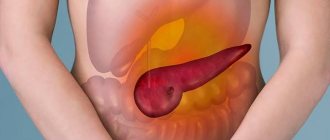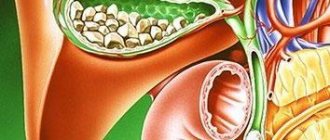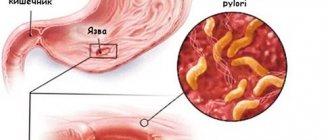We asked Larisa Tretyakova, gastroenterologist, doctor of the highest category, head of the department of the PharmMed Clinic , to tell us what most often hurts in the epigastric area, how to understand your own sensations and what diagnostic procedures are necessary in this case.
Almost every resident of a big city has experienced pain in the upper abdomen - right in the triangle under the ribs. Most often, epigastric pain indicates diseases of the digestive system.
Let's first figure out exactly what organs are located here. This is the stomach that passes into the duodenum. To the left of the stomach is the pancreas, which is responsible not only for digestion, but also for hormonal control - in particular, it produces insulin, which cells need to absorb nutrients. The spleen is also located here, which is responsible for purifying the blood and functioning of the immune system. To the right of the stomach the gallbladder and liver are densely packed. All of these organs (with rare exceptions) can be a source of pain localized in the epigastric region.
The Deepest Essence of Digestion
Every high school student knows that digestion occurs in the stomach. Aggressive hydrochloric acid attacks the food entering the stomach, and it begins to break down into easily digestible components.
| Not often, but it happens | |
| Epigastric pain may be a signal of myocardial infarction. After all, in the area of the solar plexus there are not only the digestive organs - the lungs and heart are nearby. So you should not tolerate acute abdominal pain. If it doesn’t work, call an ambulance. In addition, epigastric pain may be of neurological origin. That is, in the thoracic spine, one or another nerve is sandwiched between the vertebrae - and the signal is transmitted along the nerve to the stomach. A neurologist will be able to “decipher” such pain after an X-ray or CT scan of the spine. | |
But not every school graduate knows that a person without a stomach can live relatively normally. Because only the first stage of digestion takes place here. Much more important processes occur in the next “compartment” - the duodenum. The pancreatic ducts and the common bile duct exit here.
The gall bladder accumulates bile produced by the liver, and as soon as food enters the duodenum, the bile is sent there to help with digestion. An equally important role in digestion is played by the so-called “pancreatic juice” - the secretion of the pancreas, which also enters the duodenum through the ducts.
After food is “processed” in the duodenum, it is sent for further digestion and absorption in the small intestine.
Treatment for rib pain
Treatment of rib pain is primarily aimed at eliminating the original cause that caused it. In case of severe pain, symptomatic therapy is used. It involves the use of painkillers and anti-inflammatory drugs. If we are talking about diseases for which thermal procedures are indicated, ointments with a warming effect are used, if the pain occurs due to muscle spasms - antispasmodics.
Physiotherapeutic procedures, massage and manual therapy can relieve pain in the ribs due to osteochondrosis and hypertonicity of the pectoral muscles. After the pain goes away, the patient may be prescribed physical therapy.
In case of chest injuries, the specialists of the CELT Pain Clinic will recommend a state of rest, in which not only the injured area, but also the patient as a whole should remain. This way, healing will be much faster. Can use a chest bandage that prevents sudden movements and deep inhalations and exhalations.
By contacting the CELT Pain Clinic, you can count on professional treatment that is sure to be successful!
Make an appointment through the application or by calling +7 +7 We work every day:
- Monday—Friday: 8.00—20.00
- Saturday: 8.00–18.00
- Sunday is a day off
The nearest metro and MCC stations to the clinic:
- Highway of Enthusiasts or Perovo
- Partisan
- Enthusiast Highway
Driving directions
Gastritis, ordinary and not very
The most common disease that causes pain in the epigastric region is gastritis, that is, inflammation of the gastric mucosa. Depending on the nature of the disease, gastritis can be acute or chronic.
The danger of chronic gastritis is that most cases of stomach cancer develop against the background of a long course of this seemingly harmless disease.
The type of gastritis is divided into superficial gastritis, in which only the mucous membrane becomes inflamed, and atrophic - in this case, against the background of inflammation, the stomach glands that produce hydrochloric acid gradually die.
| How can you examine the stomach? | |
| Unfortunately, not every person can safely undergo gastroscopy. The test is not a pleasant one. Therefore, now one of the most common (albeit paid) services is gastroscopy in a dream. If you have no contraindications to general anesthesia, then you can sleep through the entire examination with a clear conscience and not get negative impressions. Another innovative research method involves the patient swallowing an endoscopic capsule. A small device goes on a journey through the digestive tract and “makes a movie” along the way. Due to the fact that such a study is the least traumatic and most informative (the esophagus, stomach and entire small intestine are examined), it costs much more than all alternatives. | |
Unfortunately, it is possible to identify the type of gastritis and, accordingly, decide on treatment only after an examination, colloquially called “gastroscopy” - during this procedure, an endoscope is inserted into the upper parts of the gastrointestinal tract.
In fact, the study is called “esophagogastroduodenoscopy”, because during the procedure the doctor examines the patient’s esophagus, stomach, and duodenum. It is very important to carry out this study in as much detail and quality as possible, since gastritis very often “adjacent” to duodenitis (inflammation of the duodenum) and pathology of the esophagus.
Diagnostic stages
1. Consultation with a gastroenterologist, who prescribes an examination plan and consultations with other specialists.
2. Examination of organs located in the upper half of the abdomen and adjacent areas.
- Laboratory tests, including blood tests, examination of secretions (stomach juice, feces, bile, etc.), tests for Helicobacter, etc.
- Endoscopic examination of the stomach, duodenum and other parts of the intestine.
- Echoscopic examinations (ultrasound), including those combined with endoscopic examinations (endo-ultrasound).
- X-ray examination, CT (including virtual colonoscopy) and MRI.
- Special studies aimed at searching for tumor formations, for example, MR diffusion (MRI tumor search).
Pancreatitis is a threat to life
Acute pain in the epigastrium can be a symptom of pancreatitis - inflammation of the pancreas. This organ can sluggishly signal a problem with regular, mild pain. And this means it’s time for an examination.
But if the pain in the epigastrium has become almost unbearable, plus stool disturbances and vomiting develop, in some cases an increase in temperature, then this means acute pancreatitis. And this is an indication for urgent hospitalization.
Pancreatitis usually occurs when pancreatic secretions (pancreatic juice) stagnate. The duct that should carry secretions into the duodenum is blocked by a stone, cyst, swelling or pus. But the juice continues to be produced and enthusiastically digests the gland itself. Therefore, in acute pancreatitis, delay is literally death.
Oddly enough, pancreatitis often attacks young people who lead an active lifestyle, love to eat, sometimes drink, and, most importantly, are subject to constant stress.
| Interesting! | |
| Vegetarians are less likely to suffer from peptic ulcers than people who eat meat. If the "ulcer" increases the fiber content in the diet, this will reduce the frequency of exacerbations of the disease. Lately, doctors have been “prescribing” fiber even during exacerbations of ulcers. | |
Problems with the pancreas can be diagnosed in advance - before the development of acute pancreatitis - using a simple ultrasound and blood test. If an ultrasound shows any problems with the pancreas, the doctor may prescribe a computed tomography scan - a study that gives a layer-by-layer image of the gland and allows you to examine in detail the essence of the problem.
Diagnosis of the pathological condition
With osteochondrosis, pain in the ribs is periodic, sometimes worsening - usually in the evening and at night, and after a night's rest it subsides. Since the thoracic part of the spine is its most sedentary part, the pain is not as pronounced as with degenerative changes in other areas. It can intensify when breathing, coughing, sighing, but still the vagueness of its manifestations makes patients suspect that they have completely different diseases.
Therefore, it is very important to conduct a thorough differential diagnosis with other pathologies using various types of research:
- X-ray of the chest and lungs, heart, spine - in several projections;
- Computed tomography or nuclear magnetic resonance scanning of the mediastinal organs and the entire chest, including spinal structures;
- Electrocardiography;
- Electromyography;
- Echocardiography;
- Examination of the vital capacity of the lungs, listening to breathing, sputum analysis and other techniques to identify respiratory pathologies;
- Dopplerography of mediastinal vessels;
- General and biochemical tests, etc.
Step by step, in a clinical setting, it is necessary to exclude the most life-threatening conditions, while simultaneously alleviating the patient’s condition with symptomatic means.
Other causes of pain
- Traumatization. In case of an unsuccessful fall, a car accident, or participation in a fight, a person develops sharp pain in the area of the right ribs. The pain syndrome may not be sufficiently pronounced and is described by the person as heaviness, aching pain in the right hypochondrium. X-rays contribute to an adequate diagnosis.
- The inflammatory process in the kidneys (pyelonephritis) is also a rather painful condition, one of the signs of which is the occurrence, due to a number of predisposing factors, of a feeling of heaviness in the right hypochondrium, radiating to the back. Accompanied by fever, frequent and painful urination.
- The abdominal form of myocardial infarction also causes burning pain in the right hypochondrium, sometimes radiating to the area of the right shoulder blade, shoulder and nausea and vomiting. The pain is combined with various arrhythmias, painful shock, pale skin, and cold, pouring sweat. The symptoms of this pathology are very similar to acute pancreatitis. Carrying out an ECG and ECHO CG helps the specialist to carry out a differential diagnosis.
- Inflammatory processes in the pancreas (pancreatitis) will manifest itself as heaviness in the right and left hypochondrium, severe flatulence, alternating constipation and diarrhea, decreased appetite, and belching. The person notes the relationship between increased discomfort and food intake. In the acute version of the pathology, the pain can be intense and have a girdling character. Complex therapeutic measures help to cope with pain in a short time.
- Exacerbation of herpetic pathology (shingles) can occur in different ways. If the rash has formed in the area of the ribs on the right, then a person with a mild course will notice a dull pain and heaviness in the right hypochondrium, the presence of single bubbles with homogeneous contents. Treatment must be comprehensive, including physiotherapy and antiviral drugs.
If you notice the symptoms described in the article, self-medication is not recommended. Therapy should be carried out by the attending physician after carrying out the necessary diagnostics.
Hepatic colic and cholecystitis
Chronic cholecystitis manifests itself as moderate pain under the right rib, radiating under the right shoulder blade or into the epigastrium. As a rule, pain occurs when the diet is violated, when eating spicy and fatty foods. Accompanied by bitter belching, vomiting, nausea, heartburn. Chronic cholecystitis is complicated by cholelithiasis, which requires surgical intervention.
Acute cholecystitis
Acute cholecystitis may be indicated by acute pain in the front of the abdomen under the right rib.
Acute cholecystitis or inflammation of the gallbladder may be indicated by acute pain in the front of the abdomen under the right rib. Unbearably acute pain forces the patient to rush around in search of a position that would help make the pain less acute.
In this case, the patient suffers from fever and incessant vomiting. The disease is accompanied by yellowing of the skin and eyeballs. If inflammation of the gallbladder is suspected, the patient must be hospitalized in the surgical department.
The occurrence of hepatic colic is associated with the entry of a stone into the bile duct. She is characterized by a stabbing pain under the ribs on the right. But there are no chills or vomiting. An attack of hepatic colic, provoked by the movement of a stone, can go away on its own after a few hours. It can be treated with antispasmodic drugs.
Non-pathogenic causes of heaviness in the right side
Discomfort in the area of the right hypochondrium can also occur in completely healthy people. It is characterized by a lack of systematicity and manifests itself with certain changes in the body itself. The most common reasons are the following:
- dietary disorders;
- excessive physical activity;
- hormonal changes during menstruation;
- pregnancy;
- stress.
Poor nutrition
When eating large amounts of fried or fatty foods, a large amount of bile is released. Bile contains special enzymes that break down fats into easily digestible fatty acids. Regulation of bile emissions is carried out by the sphincters of Oddi, Mirizzi and Lutkens.
With an increase in the volume of bile secreted, discomfort and dull aching pain in the right hypochondrium may occur. An increase in pancreatic activity may also be the cause. Therefore, after eating a large amount of “heavy” food, it is recommended to take Pancreatin to alleviate the condition of the gastrointestinal tract.
Exercise stress
One of the main functions of the liver is to maintain a reserve supply of blood. When a person experiences intense physical activity, blood from the liver enters the general circulation so that tissues and organs can receive more oxygen. Such a sudden release can cause discomfort in the right hypochondrium and even pain.
Pregnancy
During pregnancy, the growing uterus gradually displaces organs, which causes women to experience heartburn and problems with bowel function. With constant compression, the normal outflow of bile from the liver can be disrupted, which leads to a feeling of heaviness. If a pregnant woman feels systematic heaviness in the area under the ribs on the right, she needs to consult a doctor about taking hepatoprotectors and means to improve the outflow of bile.
Psycho-emotional stress
With nervous overstrain and prolonged stress, unpleasant sensations may occur in the right side. They usually go away after proper rest. Such painful sensations are caused by a sharp release of hormones, which is accompanied by a reflex contraction of the bile ducts, which causes discomfort.
If the feeling of heaviness persists for a long time, you should consult a doctor for examination and find out the reasons.
Treatment
Help before diagnosis
If the pain syndrome is minor and the general condition is satisfactory, it is recommended to limit physical activity for several days and use local anesthetics, warming and anti-inflammatory drugs. If the skin is damaged, ointments and gels should not be applied. If you feel weak, have a fever, or experience severe pain, shortness of breath, cough, or hemoptysis, you should urgently seek medical help.
Conservative therapy
The conservative treatment plan is determined by the nature of the pathology. In most cases, rest is recommended, breathing exercises and physiotherapy are prescribed. In some cases, massage and manual therapy are indicated. Drug therapy may include:
- Analgesics
. For moderate pain, tablets are used; for severe pain, medications are administered intramuscularly. In the later stages of cancer, narcotic drugs are required. - Antibiotics
. For pleurisy, purulent periostitis, osteomyelitis, antibiotic therapy is indicated. First, broad-spectrum drugs are used, then the treatment regimen is adjusted taking into account the sensitivity of the pathogen. - Hormonal agents
. Pain due to intercostal neuralgia and Tietze syndrome is successfully eliminated by blockade with corticosteroids. Blockades are performed when other methods are ineffective; the course includes no more than 3 injections of the drug. - Cytostatics
. Medicines are prescribed for malignant tumors, destroy cancer cells, and slow down the growth of tumors. They can be used as monotherapy or a combination of several agents.
Classification of pain, pain of different localizations
The most common are acute pains radiating to the back and ribs.
They are temporary. Only in 10-20% do they develop into a chronic form. Based on localization, pain is divided into: in the lumbar region. Typical for older people. They appear after long walks or excessive stress;
radiating to the back and ribs on the right. It primarily indicates the presence of an inflammatory process;
radiating to the back and ribs on the left. Appears both under load and when stationary. Especially often after a hard day at work or a long trip.
Regardless of where the pain appears, maximum attention should be given to this problem. It is recommended to listen to your own body in order to get rid of unpleasant sensations by eliminating the true cause of the pain. And there are many of them: from banal overwork to disruption of the functioning of internal organs.








